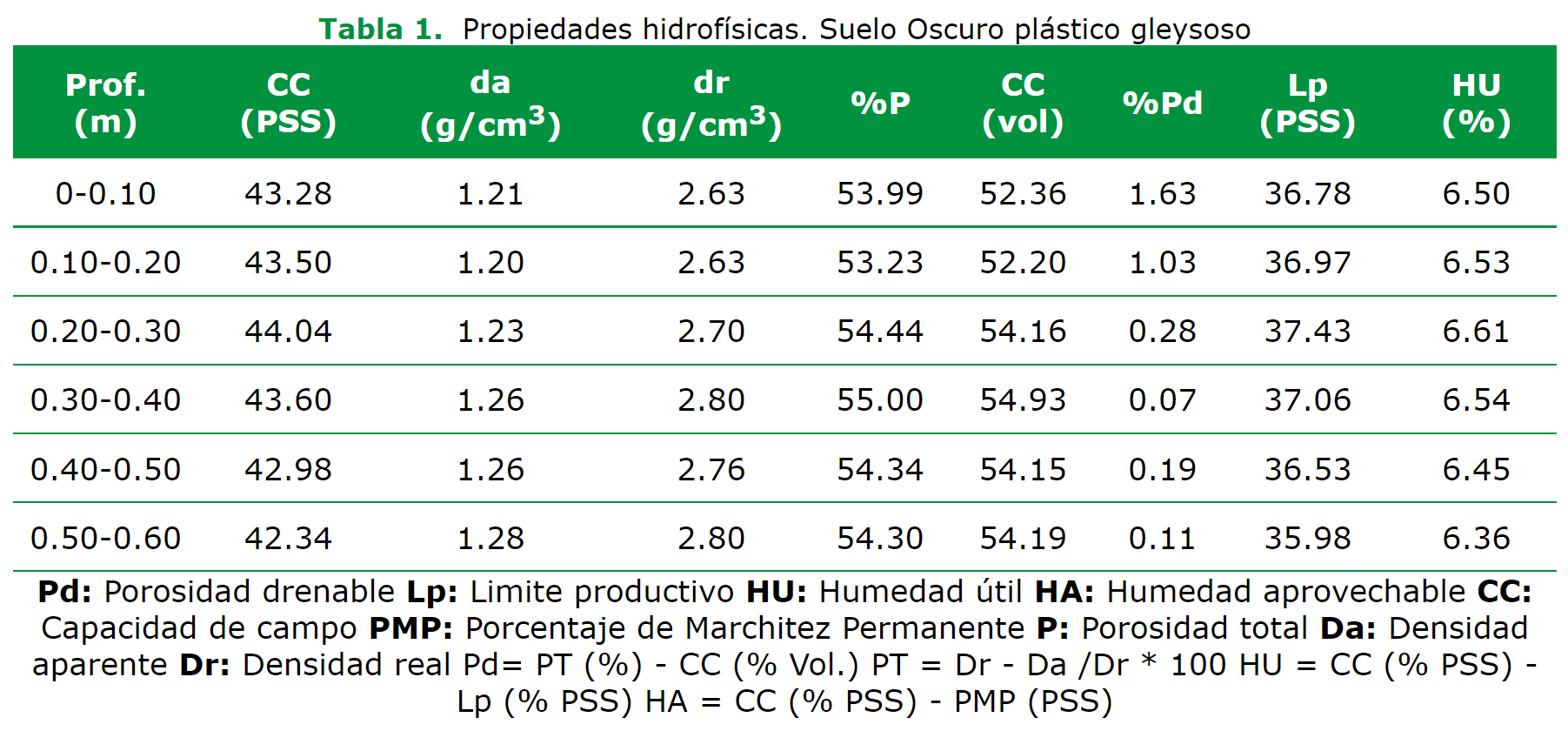Case study over physical-hydrophysical properties for irrigation and drainage in sugarcane
Main Article Content
Abstract
The work was carried out in areas of the old Complex Agroindustrial Gregorio A. Mañalich in the current province of Mayabeque. A case study was made, it consisted in determinations field and laboratory of hydrophysical and physical properties in three types of soils (Dark plastic gleysoso, Alluvial and Yellowish Ferralitic). The fundamental exit of the study is identified with the presence of soils classified as clay and plastics with hardened layers that they are characterized as of compact to very compact. The recommended irrigation technology indicates that the irrigation moment in Dark plastic gleysoso and Alluvial little differed soils it is suggested to carry out when an exhaustion is reached between 31 and 33% of available water , in the case of the Yellowish Ferralitic in 69%, the elementary drainage is suggested (solving the superficial drainage with the available means and the practical knowledge and experience of the producer) for the three types of soils to solve the glides; it is advisable the mole drainage for Dark plastic gleysoso and Alluvial soils and the deep subsoling in the Yellowish Ferralitic, this last to give solution to the subsuperficial or internal drainage.
Article Details

This work is licensed under a Creative Commons Attribution-NonCommercial 4.0 International License.
References
Arcia, F., Kauffman, J., Chang, R., & Marin, R. (1995). Cracking heavy clay reference soils (Vertisols) (19pp.). International Soils reference and Information Centre.
Cid, G., López, T., González, F., Herrera, J., & Ruiz, M. E. (2012). Características físicas que definen el comportamiento hidráulico de algunos suelos de Cuba. Revista Ingeniería Agrícola, 2(2), 25-31.
Cid-Lazo, G., Herrera-Puebla, J., López-Seijas, T., & González-Robaina, F. (2018). Estimación del agua disponible para las plantas en suelos cubanos en función de la textura predominante. Revista Ciencias Técnicas Agropecuarias, 27(4), 25-32.
Doorenbos, J., & Kassam, A. H. (1986). Efectos del agua sobre el rendimiento de los cultivos (Estudio FAO Riego y Drenaje, No. 33, Número 631.587 338.16). Organización de las Naciones Unidas para la Agricultura y la Alimentación, Roma, Italia.
Hernández-Jiménez, A., Pérez-Jiménez, J. M., Bosch-Infante, D., & Speck, N. C. (2019). La clasificación de suelos de Cuba: Énfasis en la versión de 2015. Cultivos Tropicales, 40(1).
INICA. (1995). Normas Metodológicas para Estudios de suelos y Manejo Fitotécnico de Áreas Cañeras (18pp.) [Informe Institucional]. Instituto de Investigaciones de la Caña de Azúcar (INICA), Departamento de Suelos y Agroquímica, La Habana, Cuba.
INICA. (2007). Servicio Integral de Explotación de Riego y Drenaje. (SIERIED) (82pp.) [Manejo Agronómico]. Instituto de Investigaciones de la Caña de Azúcar (INICA), La Habana, Cuba.
Kaáurichev, I. S., & Vicente, E. (1984). Prácticas de edafología. Mir Moscú, URSS.
Klimes, A., Suárez, O., & Mesa, A. (1980). Suelos de Cuba. Editorial Orbe, La Habana, Cuba.
Lamelas, C., Roque, R., Arcia, J., & García, S. (2014). Las propiedades hidrofísicas y físicas en la actividad de riego y drenaje. Revista Cuba & Caña, 2, 23-28.
López-Bravo, E. (2017). Influence of soil moisture and dry bulk density on the engineering properties of an Oxisol soil. Revista Ingeniería Agrícola, 4(2), 22-26.
Marín, R., Kauffman, J., Villegas, R., & Sánchez, M. (1994). Strongly weathered reference soils of the central and northeastern regions. Soil Brief CU 3. International Soils reference and Information Centre, 24.
Pérez, R., Fonseca, C., & Lapinel, B. (2013). Impacto del cambio climático y medidas de adaptación en Cuba. En Variaciones y cambios del clima: Vol. Capítulo 2 (pp. 43-96). Edición Científica La Habana, Cuba.
Planas, G. (1983). Correlación tentativa de los suelos incluidos en los principales sistemas taxonómicos de todo el mundo con los que se han caracterizado en Cuba por las clasificaciones morfológicas, genéticas t de aptitud para el riego (70pp.). Instituto de Hidroeeconomía, Dirección de Investigaciones Aplicadas, Departamento de Agrología, La Habana, Cuba.
Planos, E., Rivero, R., & Guevara, V. (2013). Impacto del cambio climático y medidas de adaptación en Cuba. En Cuba: Geografía, Economía y Sociedad: Vol. Capítulo 1 (pp. 21-41). Edición Científica La Habana, Cuba.
Sagardoy, J. (1998). La sostenibilidad de la gestión de los sistemas de riego y el proceso de transferencia de usuarios. Primer Taller Internacional de Riego y Drenaje, La Habana, Cuba.
